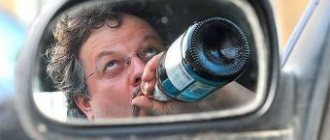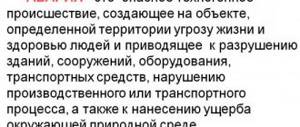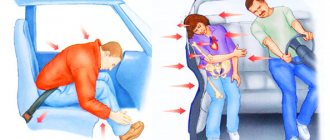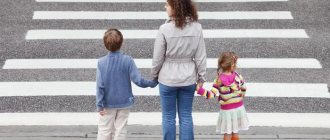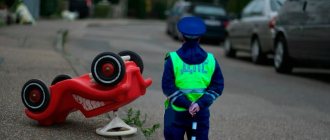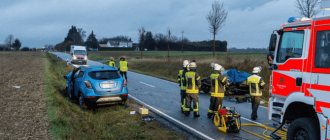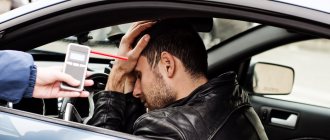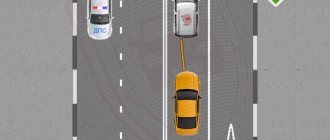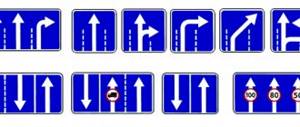Collision theory
To understand the scale of car damage after an accident, you need to clearly understand what happens directly at the moment of impact with the car body, which areas are subject to deformation.
And you will be unpleasantly surprised to learn that during a frontal impact, the rear part of the body is skewed. Accordingly, after unscrupulous body repair of the front end, even if the car was on the slipway, you will observe the trunk lid sticking, the sealing rubber rubbing, and much more. If you are interested in this topic, I suggest that you familiarize yourself with the educational material on collision theory, which was prepared by the specialists of our educational center.
General information
Collision theory is the knowledge and understanding of the forces that arise and act during a collision .
The body is designed to withstand the impacts of normal driving and to ensure the safety of passengers in the event of a vehicle collision. When designing the body, special care is taken to ensure that it deforms and absorbs the maximum amount of energy during a serious collision, while at the same time causing minimal impact on occupants. For this purpose, the front and rear parts of the body must be easily deformed to a certain extent, creating a structure that absorbs impact energy, and at the same time these parts of the body must be rigid in order to maintain a separation area for passengers.
Determination of violation of the position of body structural elements:
- Knowledge of collision theory: understanding how the vehicle structure reacts to the forces generated during a collision.
- Body inspection: search for signs indicating structural damage and its nature.
- Taking measurements: basic measurements used to identify violations of the position of structural elements.
- Conclusion: Application of knowledge of collision theory in conjunction with the results of external inspection to assess the actual violation of the position of the element or elements of the structure.
Determination of vehicle movement parameters during a cross collision
In a crossover collision, both vehicles typically undergo complex motions as the collision causes each vehicle to spin around its center of gravity. The center of gravity, in turn, moves at a certain angle to the original direction of movement.
Let's consider a cross-collision of cars that braked before the collision and left brake marks S И1
and S
Yu2
.
After the collision, the center of gravity of car 1 moved to a distance Sпн1 at an angle y1,
and the center of gravity of car 2 moved to a distance S
ПН2
at an angle
y2.
The entire amount of motion of the system can be decomposed into two components in accordance with the initial direction of movement of cars 1 and 2. Since the amount of motion in each of these directions will not change, then
where v1 /
and
v2 / -
the speed of the car is 1 to 2 after the impact.
These speeds can be found by assuming that the kinetic energy of each car after an impact is converted into friction work of the tires on the road during translational movement at a distance SПН1(SПН2) and rotation of the center of gravity through an angle
1( 2).
The work of tire friction on the road during forward motion of the car 1:
The same, when turning it relative to the center of gravity at an angle
1: .
where a1 and b1 are the distance from the front and rear axles of car 1 to its center of gravity;
R
z1
, R
z2
-
normal road reactions acting on the front and rear axles of car 1;
1 — vehicle rotation angle 1, rad;
at
— coefficient of lateral adhesion. Wherein
where L
1 - car base 1,
Hence the speed of car 1 after the collision
where L2 is the base of car 2;
a2 and
b2 - distances from the front and rear axles of car 2 to its center of gravity.
Figure 3. Cross-vehicle collision diagram.
Substituting the speed of the car after the collision into the momentum formula, we get:
Knowing the speeds v1 and v2 of the cars immediately before the collision, you can find the speeds at the beginning of the braking distance and before the start of braking.
Speed of car 1 at the beginning of the braking distance
Vehicle 1 speed before braking
The speeds of the second car are determined similarly.
The speeds of cars before a cross collision, determined in this way, are the minimum possible, since the calculations do not take into account the energy expended on the rotation of both cars. Actual speeds may be 10-20% higher than calculated.
Establishing the moment of danger to traffic.
In expert practice, the moment of occurrence of an obstacle (danger to traffic) is understood as the moment of development of a traffic situation, starting from which the driver had to take measures to prevent a traffic accident in accordance with the Traffic Rules and at which the technical ability of the driver to prevent a traffic accident is determined. -transport accident.
In general, an obstacle or danger to traffic is considered to have arisen when the driver had an objective opportunity to discover that:
— pedestrians are walking along the vehicle’s lane in the opposite or similar direction;
— the pedestrian has entered the roadway in a given direction and is approaching the vehicle’s lane (for cases where the pedestrian did not change the direction of movement before the collision);
- the pedestrian resumed movement after stopping on the roadway (for cases of changes in the pace and direction of movement by the pedestrian), if the check shows that by the time the car passed the pedestrian, the latter would not pose a danger to the movement of the vehicle. If the pedestrian still posed a danger at the specified moment, then the beginning of his movement along the roadway in this direction is taken as the moment the danger arose;
— the pedestrian appeared due to an object (moving or stationary) that limited the visibility of the driver of the vehicle;
The question of the moment of occurrence of an obstacle or danger to traffic in each specific case is decided taking into account the characteristics of the road transport situation, related, among other things, to the intensity of traffic, the behavior of traffic participants, etc.
In case of cross collision
this moment arises when the driver has the opportunity to detect that another vehicle is at such a distance from the collision site (where it would have to stop to give way) at which its driver, at the selected speed, can no longer do this (that is, when the other vehicle approached this place at a distance equal to the braking distance).
Types of collisions
When two or more objects collide with each other, the following collision options are possible:
According to the initial relative position of objects
- Both objects are moving
- One is moving and the other is stationary
- Additional collisions
In the direction of impact
- Frontal collision
- Rear collision
- Side collision
- Rollover
Let's look at each of them
Both objects are moving:
One is moving and the other is stationary:
Additional encounters:
Front collision (frontal):
Rear collision:
Side collision:
Tipping:
Influence of inertial forces during a collision
Under the influence of inertial forces, a moving car tends to continue moving in a forward direction and when it hits another object or car it acts as a force.
A car standing still tends to maintain a stationary state and acts as a force opposing another car that hits it.
When colliding with another object, an "External Force" is created
As a result of inertia, “Internal forces” arise
What is the classification of road accidents?
The Ministry of Internal Affairs divides road traffic accidents into the following types :
- collision;
- collision (on an obstacle, on a pedestrian, on a stationary vehicle, on horse-drawn vehicles);
- capsizing;
- passenger fall. This is where confusion often arises. For example, when a passenger was getting on or off, say, a bus at a stop and fell, such an incident would not be considered a traffic accident and, therefore, would not be included in this category of accident.
- other road accidents.
Types of damage
Impact force and surface
Damage will vary for given vehicles of the same weight and speed depending on the object of the collision, such as a pole or wall. This can be expressed by the equation f = F / A, where f is the magnitude of the impact force per unit surface F is the force A is the impact surface If the impact occurs over a large surface area, damage will be minimal. Conversely, the smaller the impact surface, the more severe the damage will be. In the example on the right, the bumper, hood, radiator, etc. are seriously deformed. The engine is moved rearward and the consequences of the collision reach the rear suspension.
Two types of damage
Primary damage
The collision between the vehicle and the obstacle is called the primary collision, and the damage it creates is called primary damage. Direct Damage Damage caused by an obstacle (external force) is called direct damage. Ripple Effect Damage Damage created by the transfer of impact energy is called ripple effect damage. Induced Damage Damage caused in other parts experiencing a tensile or pushing force due to direct damage or damage from the wave effect is called induced damage.
Secondary damage
When a car hits an obstacle, a large deceleration force is generated, which stops the car within a few tens or hundreds of milliseconds. At this point, passengers and objects inside the vehicle will attempt to continue moving at the vehicle's speed prior to the collision. A collision that is caused by inertia and that takes place inside the vehicle is called a secondary collision, and the resulting damage is called secondary (or inertial) damage.
Categories of violation of the position of parts of the structure
- Forward offset
- Indirect (indirect) displacement
Let's consider each of them separately
Forward offset
Indirect (indirect) displacement
What happens to a car during a high speed collision?
Physics of the collision process
When a car collides, everything happens at lightning speed, within a fraction of a second. As a result of the collision, vehicles are deformed and sometimes completely destroyed. The main factors that influence the degree of destruction are the design of the car and its speed. A shock impulse acts along the line of impact. The direction of the impact line during a car collision depends on both the direction and speed of movement. If the cars are moving at different speeds, then the line of impact will pass at a smaller angle to the axis of the car at a higher speed.
The energy that is generated during a collision.
Consider a car colliding with an obstacle. Here we can distinguish 2 stages: the moment of contact, lasting until the moment of closest approach; and the moment of movement of the car, lasting until they are separated.
At the first stage, the kinetic energy of vehicle movement is partially converted into potential energy of elastic deformation, thermal energy, etc.
Around the world, engineers are studying the effects of frontal collisions in passenger cars. There are special testing grounds. At such test sites, cars are tested for collisions. The components and parts of the front end usually suffer significant damage: bumper, hood, fenders, radiator. Such damage occurs in a matter of seconds.
Even if a car is moving at a moderate speed, its kinetic energy is high. When a car hits a stationary, solid wall of large mass, all the impact energy is absorbed. A rigid wall is practically not subject to deformation. In a head-on collision of two identical cars weighing 1800 kg at a speed of 50 km/h, we will get an effect similar to hitting a stationary wall. And if one car is moving slower than the other, then the total energy released during a collision will be less than in the previous case. A car with less weight or moving at a lower speed will receive more energy than what it had at the time of the collision.
Keep in mind that at a speed of already 100 km/h, the results of the impact will have the most dire consequences for the people in the car. Repeated tests were carried out. It is difficult to imagine what a “safe” car design would have to be to absorb such enormous energy and also ensure safety for the people in the car.
The main thing for the driver is to prevent a head-on collision. It is a frontal collision that leads to the greatest damage to the car body. In a head-on collision, the likelihood of severe injury to the driver and passengers increases many times over.
1. To avoid a head-on collision, you should try to steer the car away from the road. This could be a ditch, bush, snowdrift, etc. Do not forget that gentle slopes, as well as small bushes and snowdrifts, are less dangerous when colliding with each other than large trees, pillars or a wall.
2. Do not forget that impacts received tangentially or from behind, even leaving the road with a rollover, are less dangerous than a head-on collision.
4. Similar advice can be given in situations when a large animal appears on the road. If you do not have the opportunity to avoid such a collision, then, believe me, it is better to knock down an animal than to hit a stationary obstacle, which could be a tree or a pole. The consequences could be more dramatic.
Shock Absorption
The car consists of three sections: front, middle and rear. Each section, due to the nature of its design, reacts independently of the others in a collision. The car does not react to impact as one inseparable device. At each section (front, middle and rear), the influence of internal and (or) external forces manifests itself separately from other sections.
Places where the car is divided into sections
Crash-absorbing design
The main purpose of this design is to effectively absorb impact energy by the entire body frame in addition to the destructible front and rear parts of the body. In the event of a collision, this design ensures minimal deformation of the passenger compartment.
Front part of the body
Since the risk of collision is relatively high for the front end, in addition to the front side members, upper wing apron reinforcements and upper body side panels with stress concentration zones are provided to absorb impact energy.
Rear body
Due to the complex combination of rear quarter panels, rear floor box and spot welded elements, the impact absorption surfaces are relatively difficult to see in the rear, although the concept of impact absorption remains similar. Depending on the location of the fuel tank, the impact absorption surface of the rear floor side members is modified to absorb impact energy from collisions without damaging the fuel tank.
Typical definitions and characteristics of vehicle damage
Appendix 2 to the appendix to the Regulation of the Bank of Russia dated September 19, 2014 No. 432-P “On a unified methodology for determining the amount of costs for restoration repairs in relation to a damaged vehicle”
Typical definitions and characteristics of vehicle damage
Characteristics of the type of damage
Deviation from the correct relative position of surfaces in rotating (oscillating) cylindrical parts of machines and mechanisms
Changing the geometry of the paint coating and plastic structural materials in the form of a convexity
Violation of the operating mode of vehicle units and components, characterized by sound with a fairly constant frequency and an increased volume level relative to the permissible level
A change in the geometry of a structural element of a vehicle over part or all of its surface area in the form of a round or oval-shaped depression with smoothed edges without breaking the surface of the element (dented area)
Failure of the connection of one part (usually smaller) with another part (usually larger), accompanied by the first part falling out of the landing site located on the second part
Changing the geometry of a structural element over part or the full area of its surface in the form of a spherically curved outward shape with smoothed edges without breaks in the surface of the element
Complete separation (with separation) from a unit, unit, part of its fragment
One-sided, non-tearing separation of the surface layer of a part or part with the formation, for example, of burrs or stripes.
Complete loss of mobility of parts of components and assemblies moving during work processes, caused by mutual displacement of parts in space from the structurally specified position
Changing the geometry of a structural element by bending it up, down or backward
A type of deformation of a structural element of a vehicle, characterized by an arcuate curvature (change in curvature) of the axis of symmetry of the element or its part or surface. Main types of bends: transverse, longitudinal, longitudinal-transverse
Curvature and (or) bending of the surface of a structural element with the appearance of irregularities
Continuous damage to a structural element of small depth with smooth edges without separation of a part of the material whose length exceeds its width
Associated with the process of trace formation, the transfer of material from one object to the trace-receiving surface of another. During a traffic accident, paint, plastic, rubber or other structural materials are deposited from one vehicle onto another.
Partial destruction of a structural element of a vehicle as a result of temperature effects, including charring of its remaining part
Separating a fragment of a structural element
Separation of multilayer materials from which structural elements are made into several layers
Mutual displacement of the structural elements of a vehicle (for example, body frame, cabin, interior, platform, door openings, hood, trunk lid, windshield and rear glass, side members, frame) in space from a structurally specified position with violation of the control (basic) location limits beyond the permissible limits ) points
Division of a structural element into several small parts or complete loss of its shape and properties
A small through hole, usually round in shape
Through or non-through narrow damage of a mainly linear shape, the length of which exceeds its width, in soft materials (for example rubber, fabrics)
Through damage to a structural element of irregular shape with uneven edges without separation of part of the material (the length of the damage exceeds its width)
Damage to the surface layer of a structural element in the form of a line of insignificant depth and length
Destruction of metal over the entire thickness of a part as a result of chemical or physico-chemical interaction with the environment
Complete separation of a small fragment of the base material from the surface of the part. A special type of chip is a chip of a paint coating - a small separation of a fragment of a paint coating without damaging the material of the part.
Change in the geometry of a structural element with the formation of an unevenness in the form of a wavy or straight bend
Changing the shape of a structural element in the form of deformation around an imaginary axis
Trace of through corrosion
A sign that indirectly indicates the presence of through corrosion (for example, destruction of the paint coating of a metal part from the inside, without damaging its surface layer, rust stains)
Violation of the relative position of structural elements not provided for by its design
Violation of the operating mode of vehicle units and components, characterized by sound in the form of shock loads and an increased volume level relative to the permissible level
Partial or complete leakage of fuel and lubricants and special liquids through formed cracks and crevices
Narrow through or non-through damage to a structural element of a vehicle whose length exceeds its width
Source
The ripple effect
Impact energy is characterized by the fact that it easily passes through strong areas of the body and finally reaches weaker areas, damaging them. This is the principle of the ripple effect.
Front part of the body
In a rear wheel drive vehicle (FR), if impact energy F is applied to the leading edge A of the front side member, it is absorbed through damage to zones A and B and also causes damage to zone C. The energy then passes through zone D and, after changing direction, reaches zone E. Damage, created in zone D is shown by the rearward displacement of the spar. The impact energy then causes ripple effect damage to the instrument panel and floor box before spreading over a larger area.
In a front-wheel drive vehicle (FF), the energy from a frontal impact will cause intense destruction of the front section (A) of the side member. The impact energy, causing the rear section B of the side member to bulge, eventually causes damage to the instrument panel (C) from the ripple effect. However, the ripple effect on the rear (C), reinforcement (lower rear spar) and steering gear bracket (lower instrument panel) remains negligible. This is because the central part of the side member will absorb most of the impact energy (B). Another characteristic of a front wheel drive (FF) vehicle is also damage to the engine mounts and surrounding areas.
If the impact energy is directed towards area A of the wing apron, the weaker areas B and C along the impact path will also be damaged, allowing some of the energy to be absorbed as it travels rearward. After zone D, the wave will impact the top of the post and the roof longitudinal beam, but the impact on the bottom of the post will be negligible. As a result, the A-pillar will tilt backwards, with the bottom of the A-pillar acting as a pivot point (where it connects to the panel). The typical result of this movement is a shift in the door landing area (the door becomes misaligned).
Rear body
Impact energy on the rear quarter panel causes damage at the contact area and then at the rear quarter panel. Also, the rear quarter panel will slide forward, eliminating any gap between the panel and the tailgate. If higher energy is applied, the rear door may be pushed forward, deforming the B-pillar, and damage may extend to the front door and A-pillar. Damage to the door will be concentrated in the folded areas at the front and rear of the exterior panel and in the door lock area of the interior panel. If the rack is damaged, a typical symptom is a door that doesn't close properly.
Another possible direction of the wave effect is the path from the rear side pillar to the longitudinal beam of the roof.
In this case, the rear of the roof rail will be pushed up, creating a larger gap at the rear of the door. The junction between the roof panel and the rear side body is then deformed, causing the roof panel above the B-pillar to deform.
Classification by method of occurrence
Depending on the method or mechanism of occurrence, road accidents are of the following types.
Collision
Collisions can be of the following types:
- windshield;
- rear;
- lateral;
- tangent.
A head-on collision is a collision between vehicles traveling towards each other. This is the most dangerous type of accident, since the energy of vehicles moving towards is summed up. This type of accident often ends in death for those involved. It is most often found on intercity highways without physical separation of lanes when overtaking and entering the oncoming lane.
A rear-end collision is a collision between vehicles traveling in the same direction but at different speeds. May cause damage to multiple vehicles. The main specific reasons are failure to maintain distance, driver distraction, technical malfunctions of the brake system, and lack of studded tires in winter. Often this is also caused by driver distraction and speeding. Usually occurs on busy highways in bad weather conditions (ice, rain). Rarely leads to serious consequences.
A side collision is a collision between vehicles moving along a perpendicular path. Most often it occurs when a vehicle exits from a secondary side road onto the main road at unregulated intersections and forks. It usually occurs within the city limits. The reason is most often the inattention of the driver leaving a secondary road with limited visibility when driving away from foreign objects (advertising billboards, trees, etc.). The second reason, and even more often, an accompanying one, may be speeding by a driver driving on the main road.
A tangential collision is a collision between vehicles moving in the same direction. Occurs at uncontrolled intersections and in roundabouts when traffic rules are violated - failure to give the right of way to a vehicle according to traffic rules, or inattention when changing lanes. As a rule, it is not accompanied by serious damage.
Rollover
A rollover occurs when the speed is greatly exceeded under circumstances that are not conducive to stable movement: a sharp turn with an incline, a broken or broken wheel, a slippery road surface. It can also occur when abruptly exiting a side skid.
It is a very dangerous accident for participants, as it can lead not only to mechanical damage to the car, but also to fire as a result of fuel detonation.
Hitting a stationary vehicle
A collision with a stationary vehicle occurs within the city due to the inattention of an active participant, or due to improper parking of a stationary vehicle. Can have a wide variety of consequences depending on the speed of the moving participant.
Colliding with a pedestrian
A collision between a car and a person moving along the roadway or sidewalk is classified as a pedestrian collision. An accident in which a collision with a car in motion was initiated by a pedestrian is also interpreted. This can happen due to driver inattention, speeding, limited visibility and bad weather conditions, as well as when a pedestrian does not comply with traffic rules. From a legal point of view, the driver bears greater responsibility for such an accident as a person who has responsibility for a high-risk vehicle, a car. Therefore, if a traffic violation leads to an accident of this type, the driver will face administrative liability with a fine.
In the event of the death of a pedestrian, criminal liability arises.
Hitting a cyclist
In terms of the interpretation of guilt and legal consequences, a collision with a cyclist is similar to a collision with a pedestrian. The only difference is that from the point of view of traffic rules, a bicycle is also a vehicle and the rules for riding a bicycle differ from the rules for moving a pedestrian. A common example is a collision with a cyclist when the cyclist crosses the roadway at a pedestrian crossing while driving a bicycle, which is prohibited by traffic rules.
A cyclist's state of intoxication makes him guilty of an accident, just like driving a car.
Hitting a horse-drawn vehicle
A horse-drawn vehicle collision is a collision between a vehicle and a cart containing draft animals. This type of accident is more common in rural areas. The reason may be inattention and violation of traffic rules by the driver, insufficient interaction between the experience of the driver and the draft animals of the horse-drawn vehicle.
Hitting an animal
Hitting an animal is treated as an accident, even if the driver of the vehicle did not suffer damage, since domestic animals, according to law, are the property of their owners, and wild animals are the property of the state (Civil Code, Art. 137, Law on Animal World, Art. 4 ).
Therefore, according to the law, an accident involving animals also requires registration and compensation for damage to the injured party under compulsory motor liability insurance.
Passenger fall
According to statistics, passenger falls in public transport account for about 40% of cases in which public transport drivers violated traffic rules. Most often they occur during emergency braking. In some cases of falls, the fault of passengers who violate the rules of travel on public transport can be traced. It should be noted that if a passenger falling on a bus is interpreted as an accident, then the continuation of the bus movement is considered as leaving the scene of an accident, with all legal consequences for the driver.
Passengers falling out of a car are very dangerous, although they are rare.
Other types of accidents
Other types of accidents according to the method of occurrence include all incidents that do not fall into the described classification - for example, causing damage to people who are not participants in the traffic in a collision with a residential building, the fall of an unsecured load from a cargo vehicle, derailment of a tram, etc.
In such cases, the responsible party and the reasons for what happened are quite obvious - this is the driver of the vehicle and his behavior, which led to damage to passive participants.
- Astronomy
- Biology
- Biotechnology
- Geography
- State
- Story
- Linguistics
- Literature
- Management
- Mechanics
- Education
- Occupational Safety and Health
- Pedagogy
- Policy
- Right
- Psychology
- Sociology
- Physics
- Chemistry
- Ecology
- Electronics
- Electrical engineering
- Energy
- Jurisprudence
- Ethics and Business Communication
Sports Vehicle collision.
CLASSIFICATION OF COLLISION TYPES
I. In the direction of movement of the vehicle.
1. Longitudinal -
collision without relative displacement of the vehicle in the transverse direction, ᴛ.ᴇ. when moving in parallel courses (angle α is equal to 0 or 180 degrees).
2. Cross -
collision when a vehicle moves on non-parallel courses, ᴛ.ᴇ. when one of them shifted transversely towards the lane of the other (the angle is not equal to 0 or 180 degrees).
II.
According to the nature of mutual rapprochement of the vehicle. The sign of an accident is determined by the magnitude of the collision angle.
Based on this criterion, collisions are divided into:
1. Counter -
a collision in which the projection of the speed vector of one vehicle onto the speed direction of another is opposite to this direction; The vehicles approached each other with a deviation towards each other (angle α > 90; 270 degrees).
3. Transverse -
a collision in which the projection of the velocity vector of one vehicle onto the velocity direction of the other is O (angle α is 90; 270 degrees).
III. According to the relative location of the longitudinal axes of the vehicle.
The sign is determined by the angle of mutual arrangement of their longitudinal axes.
Based on this criterion, collisions are divided into:
1. Direct -
a collision when the longitudinal or transverse axis of one vehicle and the longitudinal axis of the second vehicle are parallel (angle α is 0; 90 degrees).
2. Oblique -
a collision in which the longitudinal axes of the vehicle were located at an acute angle relative to each other;
(angle α is not equal to 0; 90 degrees).
IV. Based on the nature of vehicle interaction upon impact.
The sign is determined by deformations and marks on the contact areas.
Based on this criterion, collisions are divided into:
1. Blocking
— a collision in which, during contact, the relative speed of the vehicle in the contact area by the time the deformations are completed decreases to 0.
2. Sliding -
a collision in which, during contact, slippage occurs between the contacted areas due to the fact that until the moment the vehicle leaves contact with each other, their speeds are not equalized.
3. Tangent -
a collision in which, due to the small amount of overlap of the contacting parts of the vehicle, they receive only minor damage and continue to move in the same directions (with a slight deviation and reduction in speed). In such a collision, horizontal traces (scratches, rubbing marks) remain in the contact areas.
V. In the direction of impact relative to the center of gravity.
The sign is determined by the direction of the vector of the resultant of the shock pulse vectors.
Based on this criterion, collisions are divided into:
1. Central -
when the direction of the collision line passes through the center of gravity of the vehicle.
2. Eccentric -
when the line of collision passes at some distance from the center of gravity, to the right (right excentric) or to the left (left eccentric) of it
.
VI. At the location of the strike.
Based on this criterion, collisions are divided into:
1. Front (frontal) -
a collision in which traces of direct contact upon impact with another vehicle are located on the front parts.
2. Front corner right and front corner left—
collision
in
3. Side right and side left -
a collision in which the impact was delivered to the side of the vehicle.
4. Rear corner right and rear corner left -
a collision in which traces of direct contact are located on the rear and adjacent side parts of the vehicle.
5. Rear -
a collision in which the contact marks caused by the impact are located on the rear parts of the vehicle.
